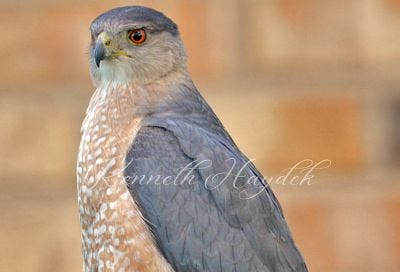April: Cooper’s Hawk
Last month, we looked at a common feeder bird, the white-breasted nuthatch (if you missed it, you can catch up here). This month, we’re discovering a bird you won’t want to see hanging around your bird feeder: the Cooper’s hawk.
Cooper’s hawks are one of three hawks of the Accipiter bird species native to North America, and they will gladly make breakfast of any medium-sized birds that congregate around your feeder or any unprotected chickens near your coop.
How will you recognize one if it is hanging around? Cooper’s hawks have broad shoulders, short, rounded wings (ideal for maneuvering through tree branches at top speeds while pursuing prey), and long, rounded tails. (Their round-ended tails are particularly worth noting as it helps distinguish them from other hawks, such as the Sharp-shinned hawk, which has a square-ended tail.)
Adult Cooper’s hawks have reddish eyes and are robed in blue-gray with reddish-brown bars interspersed throughout the white of their upper breasts. Their tails have dark bars with white. Juvenile Cooper’s hawks are hooded with brown streaks mixed in white on their upper breasts. Young Cooper’s hawks are similar in size and coloring to Sharp-shinned hawks, so watch out for that tail.
The Cooper’s hawk is a medium-sized hawk, about crow size. Interestingly, the females are larger than the males. While the males average around 14 to 15 inches with a wingspan around 24 to 25 inches, the females average around 16 to 17 inches with a wingspan around 29 to 35 inches. The females on average weigh 40% more than males.
Other than birds (robins, doves, chickens), Cooper’s hawks make meals of smaller mammals (mice, chipmunks, squirrels, bats), and the occasional lizard or insect. Cooper’s hawks are stealthy and fast—they can fly over 50 mph. Once they surprise and overtake their prey, Cooper’s hawks squeeze their prey with their talons until dead. Cooper’s hawks have also been known to hold their prey underwater until lifeless.
Hawks are gliders, compared to other birds of prey, like falcons, who are flappers. So, from a distance their flap-flap-glide wingbeat can help you spot a Cooper’s hawk. You may also hear their cak-cak-cak bird call. They tend to be more active in the morning, seeming to want to move in early and beat competition for food. In times past, you’d be more likely to see Cooper’s hawks in heavily forested areas, but nowadays some have moved into more urban and suburban areas, feeding off city-dwelling pigeons.
Cooper’s hawks like to build their nests in high places, 25 – 50 feet off the ground. The same pairs tend to reunite each mating season, having on average three to five offspring every season. Cooper’s hawks for the most part do not migrate, except those who dwell in the more northern portions of North America will go south for the winter.
Now for the big question: Who was Cooper anyway? And why did he have a hawk? Once upon a time, Cooper’s hawks were commonly called chicken hawks, due to their penchant for making poultry meals. In 1828, the French naturalist and ornithologist, Charles Lucien Bonaparte, gave the chicken hawk its first formal, scientific description and name: Falco cooperii, the name “cooperii” being given in honor of his friend and fellow naturalist William Cooper.
If you see a Cooper’s hawk hanging around your backyard, the best strategy to make him look elsewhere for food may be to take down your feeder for a while. And don’t forget to guard your chickens.
Sources:
https://www.allaboutbirds.org/guide/Coopers_Hawk
https://www.allaboutbirds.org/guide/Coopers_Hawk/id
https://www.audubon.org/field-guide/bird/coopers-hawk
https://www.birdwatching-bliss.com/accipiters.html
https://www.birdwatching-bliss.com/coopers-hawk-sharp-shinned-hawk-id.html
https://birdfeederhub.com/facts-about-coopers-hawks/
https://en.wikipedia.org/wiki/Cooper's_hawk
https://en.wikipedia.org/wiki/Charles_Lucien_Bonaparte



